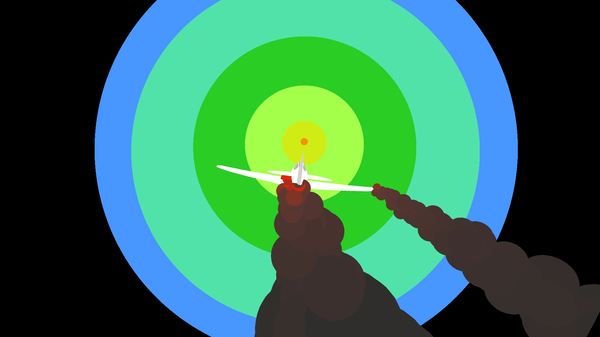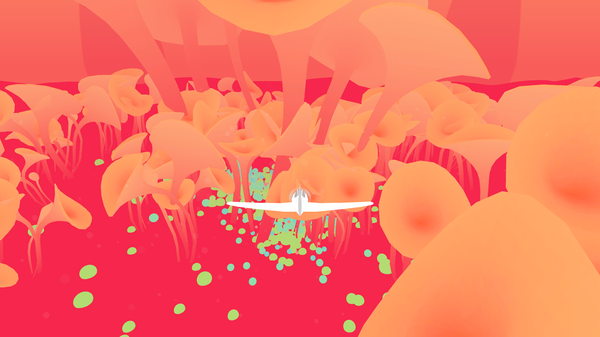Oases
Posted on Nov 16, 2015


Oases is a game released on November 11, 2015. Described as a “kaleidoscopic elegiac flyscape”, it was created by Armel Gibson and dziff, members of the Klondike Collective.
You might remember the Klondike Collective from their last work that we reviewed, Naut. This game has a lot of similarities to Naut: it’s a surreal, brightly colored jaunt throughout a mysterious, desolate landscape. The main difference is that this one takes place in an airplane. Oh, and also it’s scary.
We had discovered Oases over Twitter, where some small discussion of it had sprouted from its release. We were interested and decided to give it a look, as we had heard that it was “relaxing” and “soothing”. We’re always in the market for more games to soothe us, so we thought at first Oases and us would be a perfect match. But would it? After the jump, we’ll hop in the cockpit and find out.
The half hour
The game starts off with a plane, nosediving downwards as red smoke spews out of its body and wingtips. Just as you’re about to crash, you enter a technicolor wormhole and come out somewhere… different.

This was a blind playthrough, and we went in with no expectations, but our first impression was pretty nightmarish. Thick, thudding music overlaid a horror-scape of giant dismembered hands growing from the ground, floating fingers and palms detached from each other. That was pretty much it - we floated ethereally across an enormous landscape of hands with no end in sight. Was this the full extent of the game? Just hanging out in your airplane in Hand Hell?

After a while, we got bored and decided to crash our plane on purpose. We dive into the floor and… just get stuck? The plane clipped partially through the floor allowing us to see into the void underneath it. While trying to figure out of anything else can happen, we discover that the game has a built-in time limit. The camera iris out, and we are given a short paragraph about the creator’s grandfather. The inspiration was thus revealed: the creator’s grandpa’s airplane was reported lost during his service in the Algerian War of Independence, and the game is an artistic imagining of what could’ve happened.
Feeling like maybe we had missed something, we decided to start another game. Since there are no stated objectives or instructions on what to do, we hoped that we’d figure out the game’s intent on this play. This time we were in another landscape of hands. The worlds are randomly chosen, we discovered, so we at least had some exploring to do. We had some fun flying through the clouds and seeing the contrails they left on our wingtips, and once again hit the time limit for playing.
We found fairly quickly that the worlds in this game are gorgeous, to say the least: a sea of red hands reaching out to the bright blue sky, with light pink clouds dusting the surface. Blue mountains against pulsing blue-or-pink sky, hands with waters flowing from their fingertips to nourish gargantuan water lilies…
Seriously, though, what’s with the hands?
Yes, the first three worlds in a row that we got were hand-related. Maybe it was just bad luck.
There are more straightforwardly beautiful landscapes, of course. Our personal favorite was a field of enormous lilies, with equally-huge green spores scattered across the ground. As you fly through the spores, your plane will pick them up, leaving a trail of green from your wings. Next to that, still, was the purple forest of tall, thin trees with petals raining from the sky.

The plane physics simulation is one of the oddest we’ve experienced. It operates by normal rules, and it plays correctly by video game standards, but it doesn’t necessarily feel right: there’s no weight or drag, meaning that as you drift along, you can go up and down to your leisure. This definitely makes the game feel more like a bad fever dream, but for us personally, exploring would have felt more rewarding if you were having to work against gravity to do so. Loops are possible, though!
Some of the gameplay isn’t very intuitive: there’s a “boost” button (mapped to the space bar by default) that lets you go faster, though the game gives you no visual clues for when it recharges. Despite the implications of the intro and most other video games, flying into the floor doesn’t kill you, and you just sort of stick your nose through it. Finally, in order to opt out of a level you have to hold down (not tap) Escape, but the readme doesn’t even bother to say this and there is no visualization for it.
On the bright side, it’s relatively glitch-free. We couldn’t discover if the bounds of the game were breakable, as the timer cut us short on every attempt. You can fly through most non-floor geometry (like the hands and flowers) for no apparent reason, and you can also clip the camera through the floor, but it’s the most glitch-free Unity game we’ve played in our lives.
The only one that really bothered us was a glitch where, sometimes, the game would give up on loading a level and just kick you back to the title screen - it was outlined in the readme, and we fully expected it, but it was still jarring.

The graphics are indeed beautiful, and use a lack of textures to their advantage; less textures means less blurriness as you get closer to the geometry, so we appreciated it. This renders into a very soft, rounded visual style that is so distinctive of the Klondike collective. The real star of the show is the music: a thrumming, energetic bass drum driven tune with a surreal tone that matches perfectly with the game’s aesthetic. This game wouldn’t be half the game it is if it wasn’t for the perfect melding of visual and aural arts in play.
After the fact...
Overall, Oases doesn’t introduce anything new or game-changing, but it doesn’t need to: it does what it does wonderfully. It’s a brief, interactive painting, and a very poignant art piece based around a story from the artist’s personal life. We would say without hesitation that if you like “walking simulator” games, you will like this just as much.
Completable in half an hour: Yes
The game is beautiful without a doubt, and we feel like the 30 minutes we gave it a shot was more than enough to get a full experience out of it. Considering it’s also completely free, 30 minutes to indulge in this fantastic interactive work of art isn’t much to ask for.
You might also enjoy...
Naut, a game by the Klondike Collective. Read our review here. The aesthetic similarities are massive, but they’re a mere coincidence: they share no creators in common. However, since the two games are so similar in concept, we feel like fans of one would enjoy the other.
Naut shares Oases’ same vibrant color, frightening imagery, and general disdain for your personal comfort. Naut is a little more touchy-feely, though: instead of a plane flying through the violently visceral voids of time-space, you’re driving around the Martian countryside and talking to strangers.
Categories: gaming
Tagged: 2015 klondike collective oases pc unity walking simulator